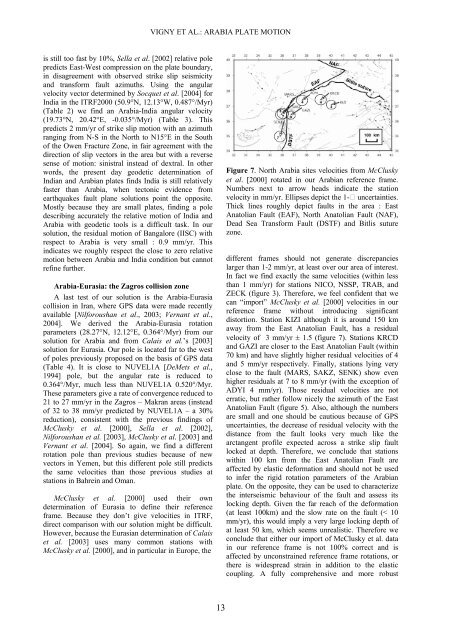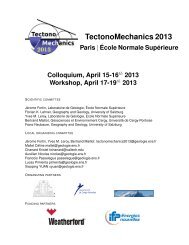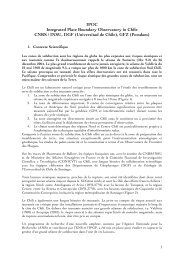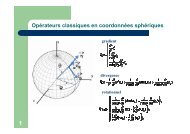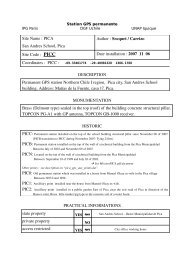PDF file - Laboratoire de Géologie de l'Ecole normale supérieure - Ens
PDF file - Laboratoire de Géologie de l'Ecole normale supérieure - Ens
PDF file - Laboratoire de Géologie de l'Ecole normale supérieure - Ens
You also want an ePaper? Increase the reach of your titles
YUMPU automatically turns print PDFs into web optimized ePapers that Google loves.
is still too fast by 10%, Sella et al. [2002] relative pole<br />
predicts East-West compression on the plate boundary,<br />
in disagreement with observed strike slip seismicity<br />
and transform fault azimuths. Using the angular<br />
velocity vector <strong>de</strong>termined by Socquet et al. [2004] for<br />
India in the ITRF2000 (50.9°N, 12.13°W, 0.487°/Myr)<br />
(Table 2) we find an Arabia-India angular velocity<br />
(19.73°N, 20.42°E, -0.035°/Myr) (Table 3). This<br />
predicts 2 mm/yr of strike slip motion with an azimuth<br />
ranging from N-S in the North to N15°E in the South<br />
of the Owen Fracture Zone, in fair agreement with the<br />
direction of slip vectors in the area but with a reverse<br />
sense of motion: sinistral instead of <strong>de</strong>xtral. In other<br />
words, the present day geo<strong>de</strong>tic <strong>de</strong>termination of<br />
Indian and Arabian plates finds India is still relatively<br />
faster than Arabia, when tectonic evi<strong>de</strong>nce from<br />
earthquakes fault plane solutions point the opposite.<br />
Mostly because they are small plates, finding a pole<br />
<strong>de</strong>scribing accurately the relative motion of India and<br />
Arabia with geo<strong>de</strong>tic tools is a difficult task. In our<br />
solution, the residual motion of Bangalore (IISC) with<br />
respect to Arabia is very small : 0.9 mm/yr. This<br />
indicates we roughly respect the close to zero relative<br />
motion between Arabia and India condition but cannot<br />
refine further.<br />
Arabia-Eurasia: the Zagros collision zone<br />
A last test of our solution is the Arabia-Eurasia<br />
collision in Iran, where GPS data were ma<strong>de</strong> recently<br />
available [Nilforoushan et al., 2003; Vernant et al.,<br />
2004]. We <strong>de</strong>rived the Arabia-Eurasia rotation<br />
parameters (28.27°N, 12.12°E, 0.364°/Myr) from our<br />
solution for Arabia and from Calais et al.’s [2003]<br />
solution for Eurasia. Our pole is located far to the west<br />
of poles previously proposed on the basis of GPS data<br />
(Table 4). It is close to NUVEL1A [DeMets et al.,<br />
1994] pole, but the angular rate is reduced to<br />
0.364°/Myr, much less than NUVEL1A 0.520°/Myr.<br />
These parameters give a rate of convergence reduced to<br />
21 to 27 mm/yr in the Zagros – Makran areas (instead<br />
of 32 to 38 mm/yr predicted by NUVEL1A – a 30%<br />
reduction), consistent with the previous findings of<br />
McClusky et al. [2000], Sella et al. [2002],<br />
Nilforoushan et al. [2003], McClusky et al. [2003] and<br />
Vernant et al. [2004]. So again, we find a different<br />
rotation pole than previous studies because of new<br />
vectors in Yemen, but this different pole still predicts<br />
the same velocities than those previous studies at<br />
stations in Bahrein and Oman.<br />
McClusky et al. [2000] used their own<br />
<strong>de</strong>termination of Eurasia to <strong>de</strong>fine their reference<br />
frame. Because they don’t give velocities in ITRF,<br />
direct comparison with our solution might be difficult.<br />
However, because the Eurasian <strong>de</strong>termination of Calais<br />
et al. [2003] uses many common stations with<br />
McClusky et al. [2000], and in particular in Europe, the<br />
VIGNY ET AL.: ARABIA PLATE MOTION<br />
13<br />
Figure 7. North Arabia sites velocities from McClusky<br />
et al. [2000] rotated in our Arabian reference frame.<br />
Numbers next to arrow heads indicate the station<br />
velocity in mm/yr. Ellipses <strong>de</strong>pict the 1- uncertainties.<br />
Thick lines roughly <strong>de</strong>pict faults in the area : East<br />
Anatolian Fault (EAF), North Anatolian Fault (NAF),<br />
Dead Sea Transform Fault (DSTF) and Bitlis suture<br />
zone.<br />
different frames should not generate discrepancies<br />
larger than 1-2 mm/yr, at least over our area of interest.<br />
In fact we find exactly the same velocities (within less<br />
than 1 mm/yr) for stations NICO, NSSP, TRAB, and<br />
ZECK (figure 3). Therefore, we feel confi<strong>de</strong>nt that we<br />
can “import” McClusky et al. [2000] velocities in our<br />
reference frame without introducing significant<br />
distortion. Station KIZI although it is around 150 km<br />
away from the East Anatolian Fault, has a residual<br />
velocity of 3 mm/yr ± 1.5 (figure 7). Stations KRCD<br />
and GAZI are closer to the East Anatolian Fault (within<br />
70 km) and have slightly higher residual velocities of 4<br />
and 5 mm/yr respectively. Finally, stations lying very<br />
close to the fault (MARS, SAKZ, SENK) show even<br />
higher residuals at 7 to 8 mm/yr (with the exception of<br />
ADYI 4 mm/yr). Those residual velocities are not<br />
erratic, but rather follow nicely the azimuth of the East<br />
Anatolian Fault (figure 5). Also, although the numbers<br />
are small and one should be cautious because of GPS<br />
uncertainties, the <strong>de</strong>crease of residual velocity with the<br />
distance from the fault looks very much like the<br />
arctangent pro<strong>file</strong> expected across a strike slip fault<br />
locked at <strong>de</strong>pth. Therefore, we conclu<strong>de</strong> that stations<br />
within 100 km from the East Anatolian Fault are<br />
affected by elastic <strong>de</strong>formation and should not be used<br />
to infer the rigid rotation parameters of the Arabian<br />
plate. On the opposite, they can be used to characterize<br />
the interseismic behaviour of the fault and assess its<br />
locking <strong>de</strong>pth. Given the far reach of the <strong>de</strong>formation<br />
(at least 100km) and the slow rate on the fault (< 10<br />
mm/yr), this would imply a very large locking <strong>de</strong>pth of<br />
at least 50 km, which seems unrealistic. Therefore we<br />
conclu<strong>de</strong> that either our import of McClusky et al. data<br />
in our reference frame is not 100% correct and is<br />
affected by unconstrained reference frame rotations, or<br />
there is wi<strong>de</strong>spread strain in addition to the elastic<br />
coupling. A fully comprehensive and more robust


